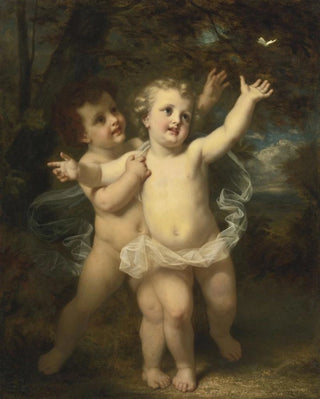Art print | The butterfly - Hugues Merle


View from behind

Frame (optional)
In the fascinating universe of art, some works manage to transcend time and capture the very essence of human emotion. "The Butterfly - Hugues Merle" is a shining example. This piece, imbued with delicacy and poetry, invites the viewer to immerse themselves in a world where the beauty of nature blends with the fragility of existence. The depiction of a butterfly, a symbol of transformation and lightness, evokes profound reflections on life, death, and rebirth. Through this work, Hugues Merle succeeds in creating a dialogue between reality and imagination, encouraging each individual to question their own quest for meaning.
Style and uniqueness of the work
Hugues Merle's style is distinguished by his ability to marry realism with romantic sensitivity. In "The Butterfly," each brushstroke seems infused with poetic intent, where light plays a crucial role. The delicate nuances of colors, ranging from pastel shades to brighter highlights, demonstrate a technical mastery that transcends simple representation. Merle does not merely paint a butterfly; he captures the lightness of its flight, the fragility of its wings, and the ephemeral beauty of its existence. This piece proves to be an ode to nature, where every detail is carefully observed and rendered with a precision that touches the soul. The floral elements accompanying the butterfly enhance this dreamlike and contemplative atmosphere, creating a visual space where one is carried away by the magic of the moment.
The artist and his influence
Hugues Merle, a French artist of the 19th century, established himself as an essential figure of the realist movement. His training with the great masters of the time allowed him to develop a unique style, blending meticulous observation with artistic sensitivity. Merle often explored themes related to nature, daily life, and the human condition, standing out for his ability to infuse emotional depth into his works. His influence extends far beyond his era, inspiring many contemporary artists who seek to capture the fleeting beauty of existence.

Matte finish

View from behind

Frame (optional)
In the fascinating universe of art, some works manage to transcend time and capture the very essence of human emotion. "The Butterfly - Hugues Merle" is a shining example. This piece, imbued with delicacy and poetry, invites the viewer to immerse themselves in a world where the beauty of nature blends with the fragility of existence. The depiction of a butterfly, a symbol of transformation and lightness, evokes profound reflections on life, death, and rebirth. Through this work, Hugues Merle succeeds in creating a dialogue between reality and imagination, encouraging each individual to question their own quest for meaning.
Style and uniqueness of the work
Hugues Merle's style is distinguished by his ability to marry realism with romantic sensitivity. In "The Butterfly," each brushstroke seems infused with poetic intent, where light plays a crucial role. The delicate nuances of colors, ranging from pastel shades to brighter highlights, demonstrate a technical mastery that transcends simple representation. Merle does not merely paint a butterfly; he captures the lightness of its flight, the fragility of its wings, and the ephemeral beauty of its existence. This piece proves to be an ode to nature, where every detail is carefully observed and rendered with a precision that touches the soul. The floral elements accompanying the butterfly enhance this dreamlike and contemplative atmosphere, creating a visual space where one is carried away by the magic of the moment.
The artist and his influence
Hugues Merle, a French artist of the 19th century, established himself as an essential figure of the realist movement. His training with the great masters of the time allowed him to develop a unique style, blending meticulous observation with artistic sensitivity. Merle often explored themes related to nature, daily life, and the human condition, standing out for his ability to infuse emotional depth into his works. His influence extends far beyond his era, inspiring many contemporary artists who seek to capture the fleeting beauty of existence.






